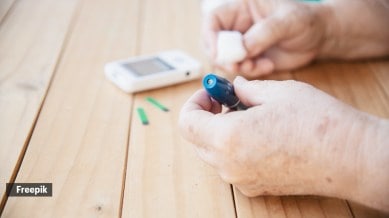📣 For more lifestyle news, click here to join our WhatsApp Channel and also follow us on Instagram
Why a fasting blood sugar of 17.5 mmol/L or 315 mg/dL is considered abnormal for a healthy adult
The risk factors include genetics, weight, and lifestyle

We have been bringing you expert-approved measures to manage blood sugar and related lifestyle issues. Today, we are here to inform you that if you have been struggling with a high fasting blood sugar, like 17.5 mmol/L or 315 mg/dL, experts urge caution. Dr. Shehla Shaikh, consultant endocrinologist at Saifee Hospital, Mumbai, noted that this number indicates a high sugar level, and the person must be “fully assessed”. “In case of initial diagnosis, it is also necessary to address the mental condition of the patient, as he/she is likely to be in a state of diabetes distress,” said Dr Shaikh.
Why does it occur?
Fasting blood sugar is typically measured after an 8- to 12-hour fast. “In healthy individuals, fasting glucose is usually between about 3.9 and 5.6 mmol/L (70–100 mg/dL). Values persistently above 7.0 mmol/L (126 mg/dL) on repeated measurements suggest diabetes, while prediabetes often falls between roughly 5.6 and 6.9 mmol/L (100–125 mg/dL). An FBS of 17.5 mmol/L is substantially elevated and warrants urgent medical evaluation,” said Dr Aarti Ullal, physician and diabetologist, Gleneagles Hospital, Parel, Mumbai.
monthly limit of free stories.
with an Express account.
According to Dr Ullal, elevated fasting glucose can occur in untreated or poorly controlled diabetes, acute stress, certain medications, infections, pancreatitis, hormonal disorders, or endocrine conditions.
“Such high levels increase the risk of dehydration, electrolyte imbalances, and diabetic ketoacidosis (DKA) in people with type 1 diabetes or severe hyperglycemia in type 2 diabetes. If someone presents with very high fasting glucose, especially with symptoms like excessive thirst, frequent urination, nausea, vomiting, abdominal pain, or fruity breath, seek prompt medical care or emergency evaluation,” said Dr Ullal.
What can help?
Diagnosis and management require professional assessment, including repeating tests, HbA1c measurement, and individualised treatment. “Lifestyle modification, glucose-lowering medications, and treatment of underlying causes will be considered based on the full clinical picture,” said Dr Ullal.
Apart from that, it is also important to reassure the patient that diabetes can be managed with proper care.
Lifestyle changes:
*Follow a dietary regimen that is reasonable and moderate.
*Increase complex carbs, check adequacy of protein, and add good fats.
Exercise:
Walking is the best and simplest form of exercise.
Aim for at least 7000 steps per day.
Adapt the activity to the individual’s age, comorbidities, and ability.
Medication:
According to Dr Shaikh, very high sugars may need short-term insulin to give the pancreas rest and make long-term diabetes management easier. “The type of medication depends on the patient’s background and symptoms,” said Dr Shaikh.
The risk factors include genetics, weight, and lifestyle. “In Indians, diabetes often occurs at a younger age and presents with higher blood glucose levels and more complications,” said Dr Shaikh.
Who should be aware
Every person should be aware of diabetes because it runs in families, stressed Dr Shaikh. “Especially Asians, since they are at increased risk. After the age of 25, Indians should check for diabetes regularly,” said Dr Shaikh.
DISCLAIMER: This article is based on information from the public domain and/or the experts we spoke to. Always consult your health practitioner before starting any routine.
📣 For more lifestyle news, click here to join our WhatsApp Channel and also follow us on Instagram